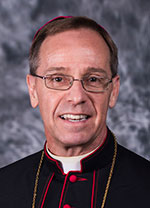Christ the Cornerstone
In death, life is changed, not ended, thanks to God’s love

“Thus it is written that the Christ would suffer and rise from the dead on the third day and that repentance, for the forgiveness of sins, would be preached in his name to all the nations, beginning from Jerusalem” (Lk 24:46-47).
Generally speaking, there are three ways to imagine what happens when a human being dies.
The first is to imagine that when someone dies, he or she enters into a kind of non-being, a shadow realm that is no longer governed by the laws of nature or material existence. This is the Hades, or Sheol, of ancient mythology. It is the world that ghosts inhabit. Nothing there seems real or permanent.
The second way to imagine what happens in death is more prosaic and clinical. Human death, like the death of animals and plants, is seen as nothing more (or less) than the physical process of disintegration that comes as a natural part of the cycle of life.
When a human being dies, this particular person is no more. All that is left is what’s in the memory of those who have survived, along with any historical writings or other artifacts that preserve some record of the deceased’s life and work.
The third way to imagine what happens to human beings after they die is to take the “shadow view” described above, turn it inside out, and make it more robust and consequential than life as we know it now.
In this radically transformed view, life after death is not a shadow but even more substantial than existence prior to death. This is what we Christians believe, namely that life after death is somehow “more real” than our present existence.
This third view of life after death is portrayed in the Gospel reading for the Third Sunday of Easter (Lk 24:35–48). Jesus appears to his cowardly disciples who are hiding behind locked doors. “Peace be with you,” he says. But the disciples “were startled and terrified and thought that they were seeing a ghost” (Lk 24:36-37). They knew that the Lord had risen from the dead, but they failed to understand what this meant in practical terms.
Jesus assures them of his identity and his reality. “Why are you troubled? And why do questions arise in your hearts? Look at my hands and my feet, that it is I. Touch me and see, because a ghost does not have flesh and bones as you can see I have” (Lk 24:38-39). And as he said this, St. Luke tells us, “He showed them his hands and his feet” (Lk 24:40).
The disciples remained skeptical, only halfway convinced. The Gospel records that while “they were still incredulous for joy and were amazed” (Lk 24:41), Jesus asked them, “Have you anything here to eat?” (Lk 24:41)
St. Luke tells us that “they gave him a piece of baked fish; he took it and ate it in front of them” (Lk 24:43). Jesus did this not because he was hungry or because he needed earthly food, but because he wanted to prove to them that he was not a ghost, but a real human being whose life was changed, not ended.
We affirm this fundamental belief every time we celebrate someone’s Mass of Christian burial. Life is changed, not ended, by death. Further, we proclaim boldly that we will all rise again on the last day, and that when we rise again our souls and our bodies will be reunited in a way that is radically transformed from our current earthly existence.
This tenet of our Christian faith (“the resurrection of the body”) is scandalous to modern minds. Our contemporary culture asserts that death is the absolute end, and that after death we are no more than a distant memory or a footnote in the history of the world.
And yet, the Gospel tells us that those who have died in Christ will live with him. We will not be ghosts. Like him, we will be real human beings (body and soul) whose lives have changed, not ended.
In the meantime, the Gospel tells us that we have work to do. We are witnesses to the great miracle of Jesus’ resurrection, and we have been commissioned by him to “preach in
his name to all nations” (Lk 24:47) the good news that if we believe in him, and follow him, we can have life eternal.
As we continue our joy-filled celebration of the great mystery of Jesus’ resurrection from the dead, let’s not hesitate to proclaim with our words and our actions that Christ is risen. That God’s love is stronger than death. And that we, too, will rise again one day—not as ghosts but as real human beings whose lives have been transformed, not ended. †
